In the vast expanse of North America, a total of 11 wren species have been spotted, and within the confines of South Dakota, an impressive 9 of these species have made an appearance. Among the wrens found in South Dakota, 8 species are considered regular residents, while 1 species is an accidental visitor. This comprehensive guide aims to assist you in identifying these avian creatures based on their physical attributes and melodic calls.
Throughout the year in South Dakota, you can encounter two wren species: the Carolina Wren and the Canyon Wren. These delightful songbirds grace the state with their presence, showcasing their enchanting melodies and captivating appearances. During the summer months, additional wren species make their way to South Dakota. These include the House Wren, Marsh Wren, Rock Wren, and Sedge Wren. As for wrens observed during migration, the Winter Wren is the one to keep an eye out for. Lastly, there are two other wrens, namely the Pacific Wren and Bewick’s Wren, that bird enthusiasts should be on the lookout for while exploring the South Dakota wilderness.
Wrens, although modest in appearance, possess charismatic personalities. These unassuming birds are small, plump, and adorned in shades of brown. They boast distinctive upright tails and project their voices with considerable volume.
Belonging to the Troglodyidae family, wrens are native to the New World, encompassing the Americas. However, the Eurasian Wren deviates from this pattern and can be found in Europe and Africa, representing the Old World. Thriving on a diet primarily composed of insects and spiders, wrens exhibit adaptability to survive in diverse environments, including arid regions with limited vegetation and rocky landscapes.
In the past, there was a misconception that the Winter Wren, Pacific Wren, and Eurasian Wren were a single species. However, recent scientific consensus has recognized them as distinct species, each possessing its own set of characteristics.
Throughout history, wrens have held significant cultural and symbolic meaning, with folklore often associating them with various beliefs. In Europe, it was once believed that harming these birds would invite misfortune.
To aid in the identification of wren species found in South Dakota, this guide has been developed in accordance with avibase, an invaluable resource for bird enthusiasts. The wrens listed below are arranged based on their frequency of sightings, with the most commonly observed species listed first and the least frequently observed species listed last. This order has been determined by avid bird watchers who contribute their checklists to ebird, an online platform for birding observations.
For a comprehensive collection of bird identification photographs specific to South Dakota, you can acquire a printable guide to assist you in recognizing the various avian visitors gracing your backyard.
South Dakota is home to 9 species of wrens:
1. House Wren
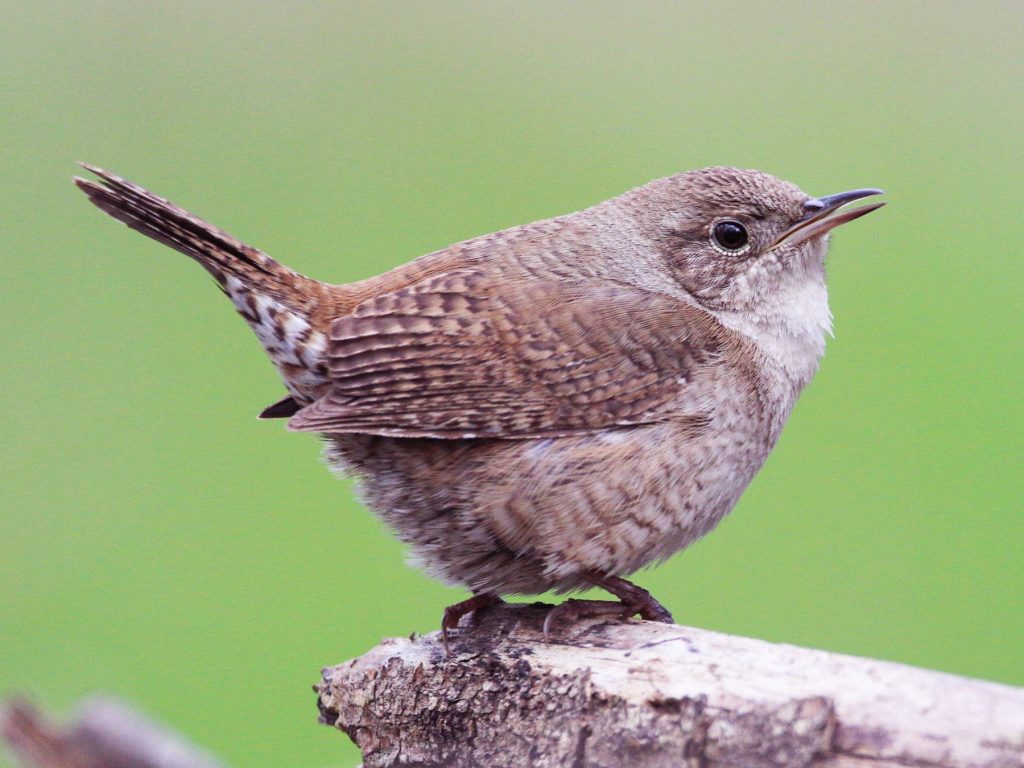
The House Wren, a summer resident of South Dakota, is a frequent sight, making appearances on 21% of summer checklists submitted by bird watchers. These charming birds arrive as early as March and stay until October before migrating south for the winter. House Wrens are small, unremarkable brown birds with darker barred wings and tails, along with paler throats. Both males and females share similar appearances. Compared to other wren species, their eyestripe is less prominent.
Scientific Name: Troglodytes aedon
Length: 4.3-5.1 inches (11-13 cm)
Weight: 0.3-0.4 ounces (10-12 g)
Wingspan: 5.9 inches (15 cm)
During the summer, House Wrens engage in breeding activities across the United States and Southern Canada. Their foraging
habits lead them to backyards, parks, and open woods in search of insects and spiders. Energetically hopping through foliage with tails held upright, they pause occasionally to delight listeners with their cheerful songs. In addition to insects, House Wrens supplement their diet with snail shells for an extra dose of calcium.
When it comes to their vocalizations, House Wrens may lack tunefulness but make up for it with a series of jumbled notes that vary in pitch and speed.
Nest building is a characteristic behavior of House Wrens, with old woodpecker holes, nest boxes, and small crevices serving as their preferred nesting sites. These resourceful birds construct nests from twigs and line them with softer materials. They typically lay 3 to 10 eggs, requiring approximately two weeks for hatching, followed by an additional two weeks for the chicks to fledge.
To attract House Wrens to your backyard, consider leaving piles of brush or installing nest boxes.
Fun fact: Despite their small size, House Wrens display a fierce demeanor, often harassing larger birds to claim the best nest holes. On occasion, they may even remove eggs or nestlings from a site they desire.
2. Marsh Wren
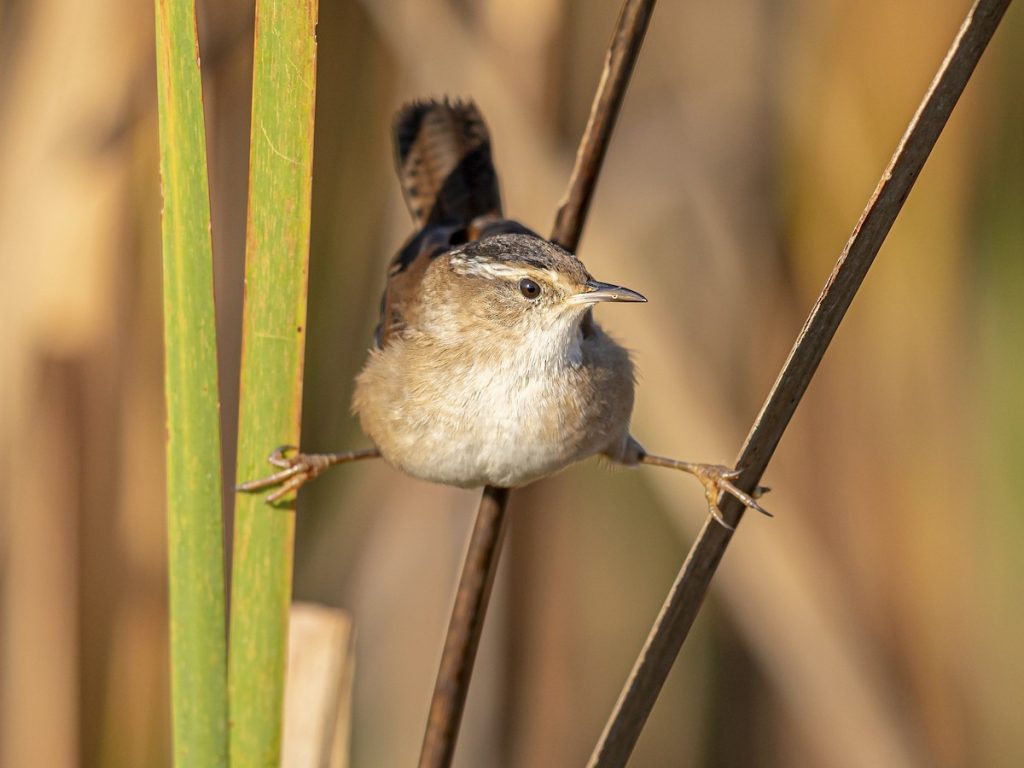
During the breeding season, Marsh Wrens can be observed in South Dakota, appearing on 4% of summer checklists. Although a few individuals may reside throughout the year, the prime months for spotting Marsh Wrens are May to October.
Marsh Wrens exhibit brown plumage with black and white streaks on their backs, while their underbellies possess a grayish-brown hue. Like other wren species, they possess the characteristic upright tail. Notably, Marsh Wrens lack striped shoulders and boast longer bills compared to Sedge Wrens. Males and females exhibit similar physical traits.
Scientific Name: Cistothorus palustris
Length: 3.9-5.5 inches (10-14 cm)
Weight: 0.3-0.5 ounces (9-14 g)
Wingspan: 5.9 inches (15 cm)
Marsh Wrens breed in the northern states of the US and central Canada before migrating to southern states and Mexico. While migrating, they can be spotted in the eastern regions of the US.
To catch a glimpse of Marsh Wrens, explore wetlands where they cling to reeds, gripping separate stalks with their feet. Although they can be challenging to spot, their distinctive songs resonate among the reeds, particularly during dawn and dusk. In terms of diet, Marsh Wrens primarily feed on insects and spiders, which they pluck from leaves near the water’s edge.
When it comes to vocalizations, Marsh Wrens emit a distinctive buzzy song that can extend for up to 20 minutes.
Marsh Wrens construct fully enclosed nests, featuring a small opening at the top. These nests are woven from reeds and grasses. They typically lay 3 to 10 eggs, requiring approximately two weeks for hatching and an additional two weeks for the chicks to fledge.
Fun fact: Marsh Wrens have been known to construct up to twenty dummy nests attached to cattails. However, they typically utilize only one nest, often destroying the eggs and nestlings of rival birds.
3. Rock Wren
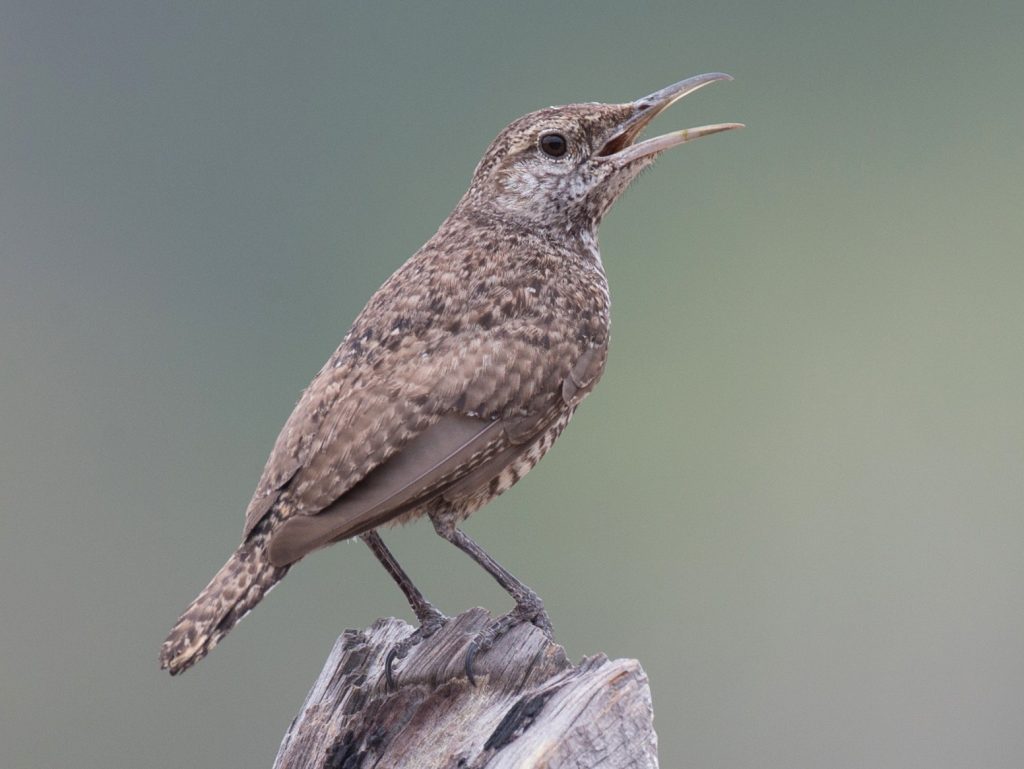
Among South Dakota checklists, Rock Wrens were observed on 3% of surveys conducted during the summer season. These birds breed in South Dakota from mid-April until October.
Rock Wrens possess pale brown plumage adorned with darker flecks. Their wings and tails display barring, while the underparts maintain a pale coloration. However, their lower flanks and bellies feature buff coloring. Notable physical characteristics include a pale eyebrow stripe, a long slightly curved bill, and dark legs. Males and females share similar appearances. Rock Wrens engage in characteristic bobbing motions, especially when agitated, providing a helpful identification clue.
Scientific Name: Salpinctes obsoletus
Length: 4.9-5.9 inches (12.5-15 cm)
Weight: 0.5-0.6 ounces (15-18 g)
Wingspan: 8.7-9.4 inches (22-24 cm)
Rock Wrens are primarily found in dry, rocky areas within western US states and southwestern Canada. While those in the southern and western regions remain year-round, individuals residing in central US states migrate south for the winter.
To spot Rock Wrens, explore dry and rocky environments with limited vegetation. These birds feed on insects nestled within crevices.
Rock Wrens are known for their diverse repertoire of songs, which can consist of over 100 different tunes. They often repeat the same sound multiple times before transitioning to a different pitch.
When it comes to nesting, Rock Wrens build their nests on the ground, typically in cavities or depressions within rocky areas. They incorporate small stones into the nest structure, followed by softer materials like wool and moss. Rock Wrens may lay up to 8 eggs and raise up to 3 broods in a single year.
Fun fact: Rock Wrens construct pathways made of stones and various objects leading to their nests. The purpose of this behavior remains unknown. Additionally, these resourceful birds acquire all the necessary moisture from their insect diet, rendering the need to drink water obsolete.
4. Sedge Wren
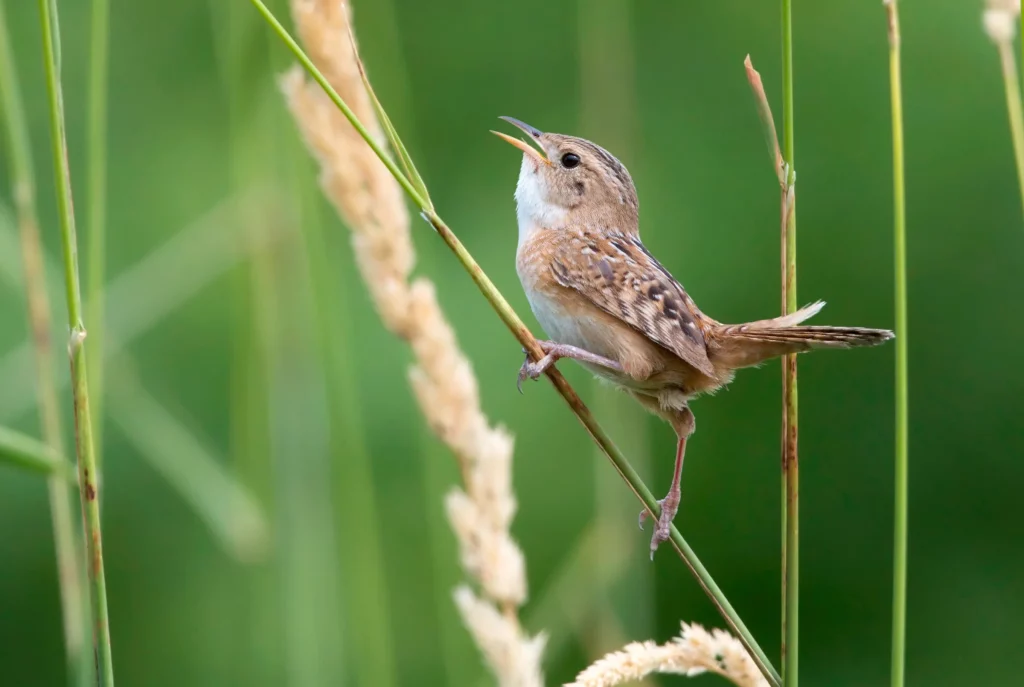
Sedge Wrens are a summer presence in South Dakota, observed from March until November. However, they are most commonly spotted between May and October, appearing on 3% of summer checklists.
Sedge Wrens sport small brown bodies with darker upper parts featuring streaks and barring. Their underparts exhibit a paler coloration. These wrens possess a light eyebrow stripe, and both males and females share similar physical characteristics. While they resemble Marsh Wrens, Sedge Wrens lack striped shoulders and exhibit lighter bellies.
Scientific Name: Cistothorus stellaris
Length: 3.9-4.7 inches (10-12 cm)
Weight: 0.3-0.3 ounces (7-10 g)
Wingspan: 4.7-5.5 inches (12-14 cm)
Sedge Wrens breed in southern Canada, the Midwest, and sometimes the eastern US. During winter, they migrate to southeastern states and northern Mexico, residing near the Gulf and Atlantic coasts.
To locate Sedge Wrens, explore hidden wet grasslands, marshy areas, and meadows rich in vegetation. These wrens tend to favor shallower areas compared to Marsh Wrens, and they actively search for insects and spiders.
Sedge Wrens produce a simple song consisting of a few short notes followed by a series of rapid notes with similar pitches.
Their nests are cup-shaped and constructed from twigs and grasses woven together. Sedge Wrens usually lay 3 to 10 eggs, which hatch within two weeks. The chicks require another two weeks to fledge.
Fun fact: Sedge Wrens display a territorial behavior by piercing the eggs of nearby Sedge Wrens, effectively eliminating the competition.
5. Canyon Wren
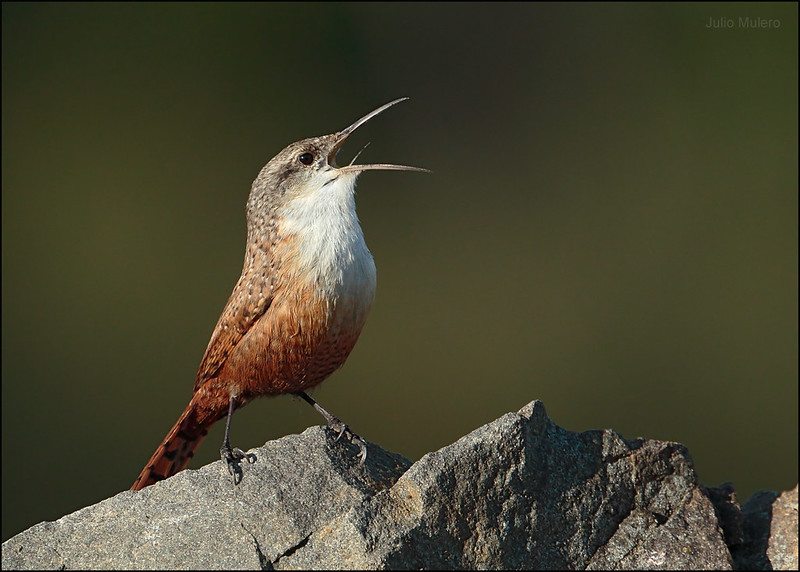
While not particularly common in South Dakota, Canyon Wrens can be observed throughout the year, mainly in the southwestern region of the state.
Canyon Wrens possess stocky brown bodies with white throats and lighter barred tails. Their heads exhibit a grayish-brown hue with speckling. Notably, they have short, strong legs enabling them to cling to rocks. Males and females share similar physical traits. These wrens inhabit rocky areas similar to Rock Wrens, but they can be distinguished by their white throats and dark bellies.
Scientific Name: Catherpes mexicanus
Length: 4.5-6.1 inches (11.4-15.4 cm)
Weight: 0.3-0.7 ounces (9.9-18.3 g)
Wingspan: 7.1-7.9 inches (18-20 cm)
Canyon Wrens are predominantly found in western regions, spanning from southern British Columbia down through western US states into Mexico. Unlike other wren species, they do not migrate.
To spot Canyon Wrens, explore rocky environments where they forage for insects and spiders nestled within crevices. Their short, strong legs enable them to cling to rocks, even scaling vertical cliffs.
Canyon Wrens emit a distinct descending song that gradually slows and concludes with a few raspy notes.
Nests of Canyon Wrens are constructed within crevices using twigs and grasses, often lined with wool and feathers.
Fun fact: Canyon Wrens possess a unique habit of pilfering food from spider webs and wasp nests.
6. Winter Wren
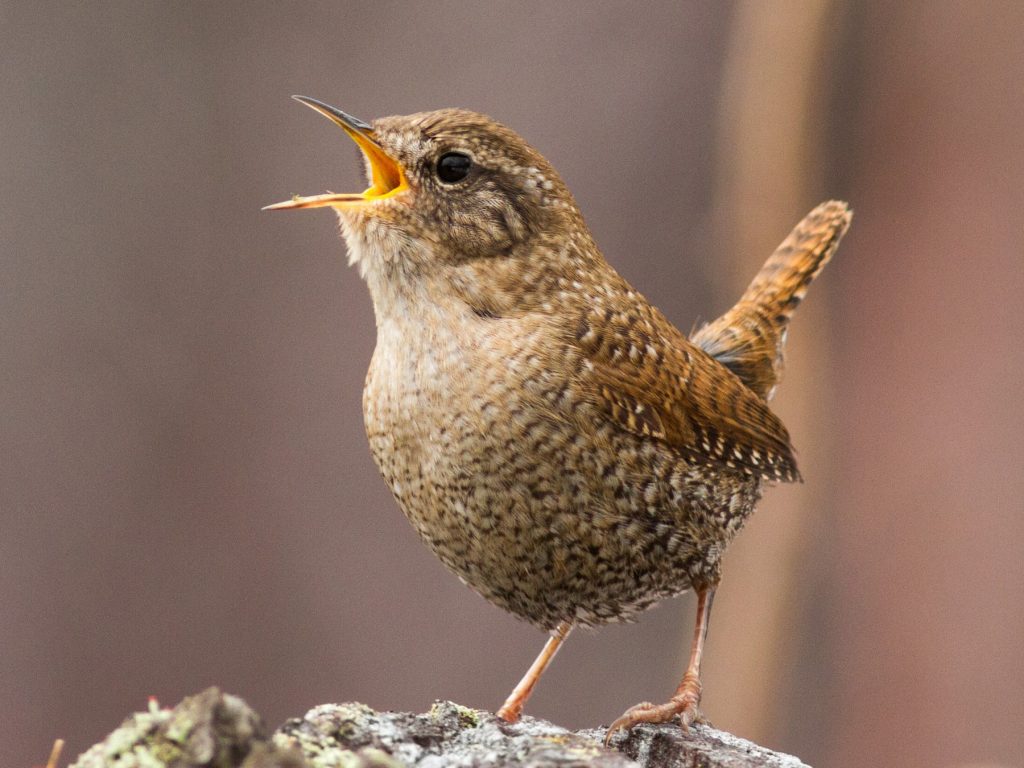
Winter Wrens can be observed in South Dakota during the spring and fall migration, with the highest frequency occurring in October. They appear on 1.1% of checklists during this time.
Winter Wrens exhibit small, plump bodies covered in brown plumage. Their wings, tail, and belly display darker barring, while a paler eyebrow stripe adds contrast. These wrens possess short tails that are typically held upright. Males and females share similar physical characteristics. Winter Wrens bear a striking resemblance to Pacific Wrens, and the two species were previously considered the same. However, they have now been classified as distinct species due to their unique songs.
Scientific Name: Troglodytes hiemalis
Length: 3.1-4.7 inches (8-12 cm)
Weight: 0.3-0.4 ounces (8-12 g)
Wingspan: 4.7-6.3 inches (12-16 cm)
Winter Wrens can be found in eastern US states during the winter and in northeastern US states and Canada during the summer.
To locate Winter Wrens, explore tangled undergrowth in forests and backyards. They rely on fallen leaves and decaying bark as their foraging grounds, where they hunt insects and spiders.
Winter Wrens produce a long, bubbly, and sweet song that lasts up to 10 seconds. Their vocalizations are slower compared to Pacific Wrens.
Nests of Winter Wrens are composed of twigs, moss, and grass woven together into a round shape, featuring a small opening. They lay 1 to 9 eggs, which hatch within two weeks. The fledging process takes another two weeks.
Attract Winter Wrens to your backyard by cultivating native plants and maintaining dense vegetation.
Fun fact: Winter Wren nests are often round in shape and may even hang from trees.
7. Carolina Wren
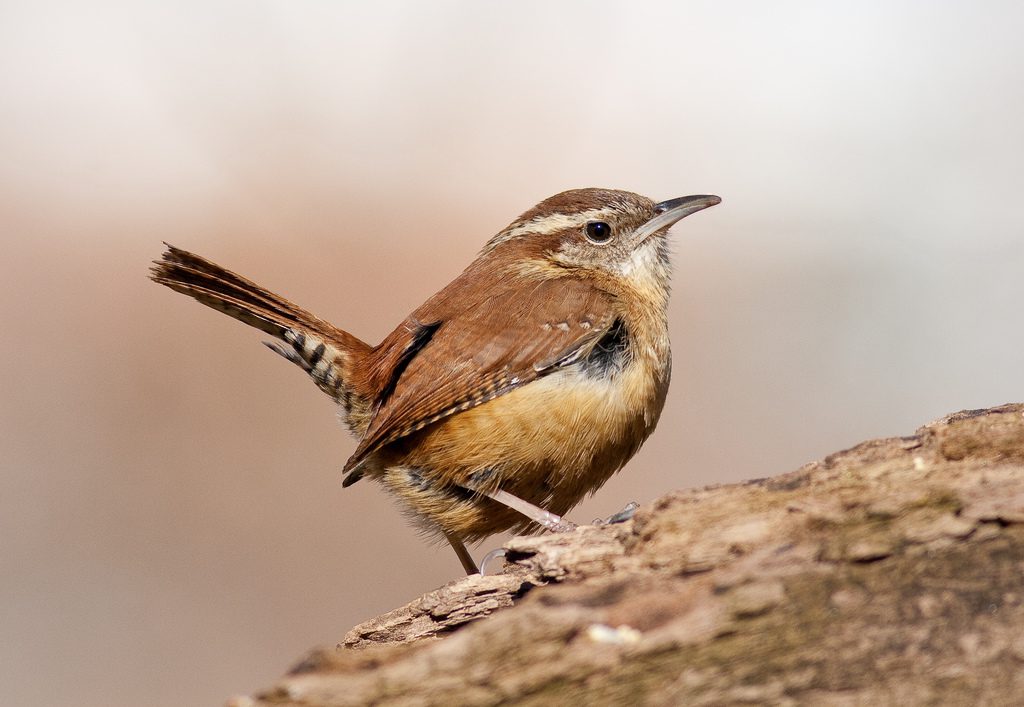
Carolina Wrens, while rarely spotted in South Dakota, are known to be regular residents throughout the year.
Carolina Wrens possess dark brown plumage on their upper parts and light brown underneath. They feature a white eyebrow stripe and an upright tail.
Scientific Name: Thryothorus ludovicianus
Length: 4.7-5.5 inches (12-14 cm)
Weight: 0.6-0.8 ounces (18-22 g)
Wingspan: 11.4 inches (29 cm)
Carolina Wrens inhabit Eastern and Southeastern states, remaining in these regions year-round.
To spot Carolina Wrens, explore wooded areas and dense vegetation. These birds occasionally visit backyard feeders and consume insects and spiders, supplementing their diet with lizards, frogs, and snakes.
Carolina Wrens produce short songs consisting of quick whistles.
Nests of Carolina Wrens are typically found in trees, although they exhibit adaptability and may build nests in various natural or artificial structures. Their nests are nearly circular, featuring a small opening on the side. Carolina Wrens lay 3 to 7 eggs, requiring approximately two weeks for hatching and an additional two weeks for the chicks to fledge.
To attract Carolina Wrens to your backyard, consider offering suet feeders, hulled sunflower seeds, or peanut hearts in large tube feeders or platform feeders.
Fun fact: Carolina Wrens are known to form lifelong pair bonds.
8. Pacific Wren
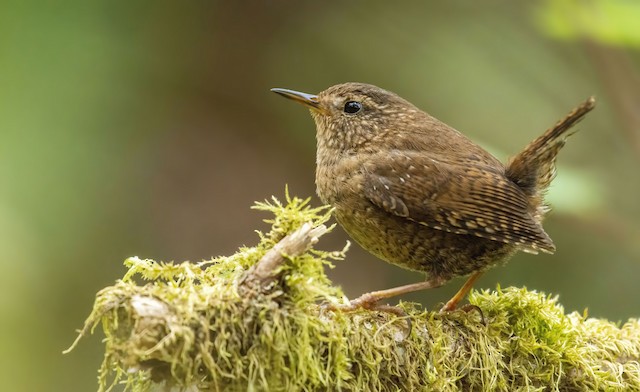
Pacific Wrens, while rarely observed in South Dakota, are considered regular visitors to the region. Their presence was recently documented in the Black Hills National Forest in 2021.
Pacific Wrens exhibit brown plumage throughout their bodies, featuring darker barring on the wings, tail, and belly. They possess a paler eyebrow stripe and short tails held upright. Males and females share similar physical traits. Notably, Pacific Wrens represent the smallest wren species in the United States.
Scientific Name: Troglodytes pacificus
Length: 3.1-4.7 inches (8-12 cm)
Weight: 0.3-0.4 ounces (8-12 g)
Wingspan: 4.7-6.3 inches (12-16 cm)
Pacific Wrens are found along the West Coast, ranging from Alaska to California. Coastal individuals remain year-round, while those residing inland migrate south for the winter.
To locate Pacific Wrens, explore forests where they tend to remain hidden among the masses of leaves and decaying logs. They feed on insects, spiders, flies, and bees.
Pacific Wrens produce a long, jumbled song comprising numerous fast, high-pitched notes.
Nests of Pacific Wrens are similar to those of other wren species, constructed from twigs, moss, and grass. These nests are round in shape, often featuring a small opening. Pacific Wrens lay 1 to 9 eggs, with a two-week incubation period and subsequent fledging.
Attract Pacific Wrens to your backyard by cultivating native plants and dense vegetation. Additionally, consider installing a nest box to provide suitable nesting sites.
Fun fact: Pacific Wrens often huddle together in cold weather, with multiple individuals sharing a single cavity or nest box. In some instances, over 30 Pacific Wrens have been found together in a nest box.
9. Bewick’s Wren

Bewick’s Wrens are considered accidental species in South Dakota, with no recent sightings according to available records.
Bewick’s Wrens exhibit brown-backed bodies with long, gray, upright tails displaying darker barring. They possess gray bellies and a white stripe above the eye.
Scientific Name: Thryomanes bewickii
Length: 5.1 inches (13 cm)
Weight: 0.3-0.4 ounces (8-12 g)
Bewick’s Wrens reside throughout the year in southern and western states, occasionally making small movements during winter.
To spot Bewick’s Wrens, explore scrublands, thickets, and open woodlands. These wrens hop from branch to branch, showcasing their long tails. In terms of diet, Bewick’s Wrens primarily consume insects and larvae, including bees, bugs, caterpillars, and beetles.
Bewick’s Wrens produce songs featuring a couple of short higher notes followed by lower-pitched buzzy notes.
Nests of Bewick’s Wrens are built on rock ledges, old woodpecker nests, nest boxes, or crevices in buildings. They construct cup-shaped nests using sticks and grasses, lining them with softer materials. Bewick’s Wrens lay 3 to 8 eggs, with a two-week incubation period and subsequent fledging.
To attract Bewick’s Wrens to your backyard, offer suet, mealworms, and hulled sunflower seeds.
Fun fact: House Wrens may have contributed to the decline of Bewick’s Wrens in the eastern United States as they would destroy their eggs.
How to Attract Wrens to Your Backyard
Having wrens visit your backyard allows for the enjoyment of their beautiful songs and the opportunity to observe their energetic behavior up close. While only a few wren species are regular backyard visitors, such as House Wrens, Carolina Wrens, and Bewick’s Wrens, you can take steps to attract them.
Consider the following ideas to attract wrens to your backyard:
1. Embrace a slightly untidy yard: Provide habitats for insects and spiders, which serve as wren favorites. Leave fallen leaves and create brush piles to encourage a thriving insect population.
2. Offer clean water sources: Consider installing birdbaths or providing running water in multiple locations.
3. Provide nesting sites: Wrens utilize nest boxes or may even make use of old boots left in the yard.
4. Offer a varied food selection: Wrens are known to consume mealworms, crickets, peanuts, and suet. Experiment with different feeders and food options to see what they prefer.
How Frequently Wrens are Spotted in Summer and Winter in North Dakota
Checklists provide valuable insight into the frequency of bird sightings. Based on eBird checklists, the following wren species are commonly recorded in North Dakota during summer and winter:
Wrens in North Dakota in Summer:
1. House Wren – 21.5%
2. Marsh Wren – 4.2%
3. Rock Wren – 3.1%
4. Sedge Wren – 3.0%
5. Canyon Wren – 1.3%
6. Pacific Wren – 0.1%
7. Carolina Wren – <0.1%
8. Winter Wren – <0.1%
Wrens in North Dakota in Winter:
1. Canyon Wren – 0.2%
2. Carolina Wren – 0.2%
3. Winter Wren – 0.1%
4. Marsh Wren – 0.1%
5. Pacific Wren – 0.1%